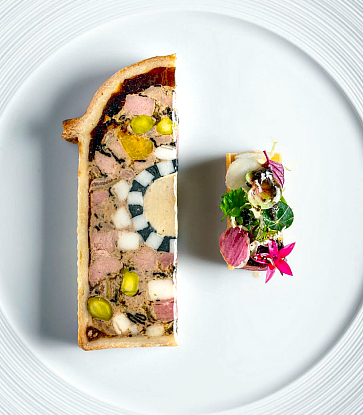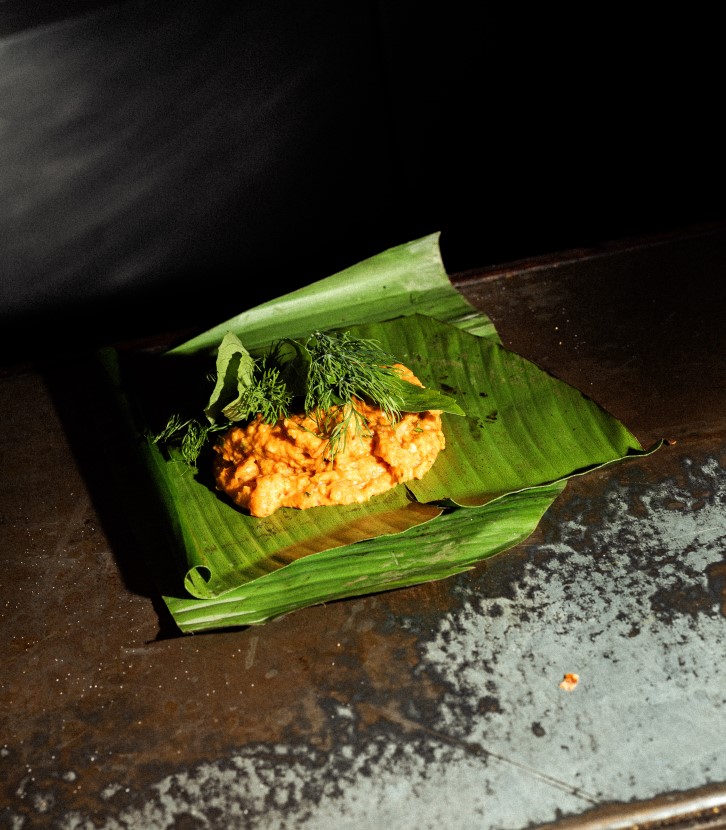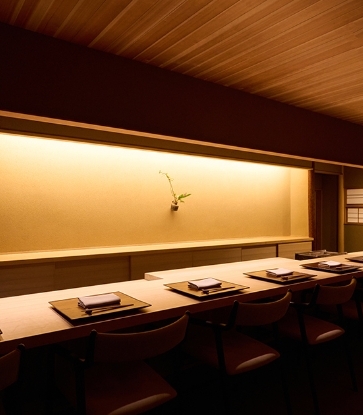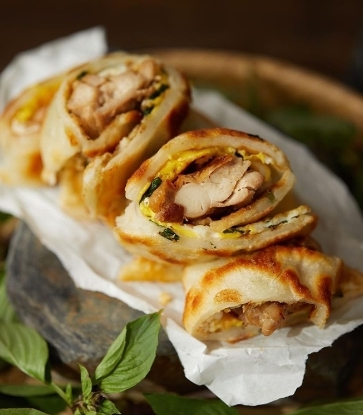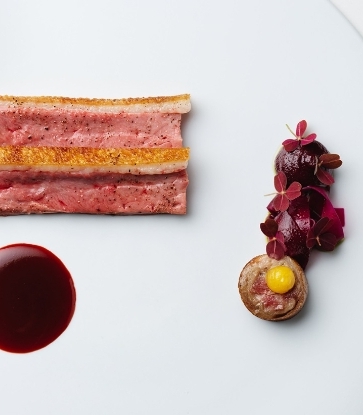Taiwan's culinary scene is enriched by the island’s diverse and abundant seasonal ingredients.
In spring and summer, the rains bless the land with vitality and nature offers its treasures. Tender shoots of vegetable fern, dragon beard greens, and bird's nest fern flourish under gentle showers, while Makino bamboo shoots emerge from the earth, marking the arrival of spring’s finest delicacies.
Across the city, restaurants embrace the rhythm of the seasons, drawing inspiration from nature's bounty, and artfully transforming the distinct flavors of wild vegetables and fresh produce into exquisite dishes, extending the beauty of spring to the taste buds.
Here are five MICHELIN-recommended spots where you can sample the wild, vibrant essence of nature in every bite.
Stir-Fried Seasonal Vegetables with Wax Apple
Fujin Tree Taiwanese Cuisine & Champagne (Songshan)
One MICHELIN star, MICHELIN Guide Taiwan 2024
This dish evolves with the changing seasons, taking on different versions throughout the year. In winter, vegetables like choy sum (a leafy green) and pea shoots are used. In spring, the dish is packed with gai lan, chayote (a green squash), and locally sourced wax apples.
Gai lan, also known as Chinese kale, has stems and leaves that release a slightly bitter, spicy flavor when damaged — a natural defense against pests that also imparts a distinctive taste. Spring-harvested gai lan is especially aromatic, with a rich and concentrated fragrance.
The chef carefully selects slender, straight-stemmed gai lan with thick leaves, stir-frying it briskly with aged ginger to retain its crunch. Sweet and crisp wax apples are added to balance the vegetable’s subtle bitterness, while chayote lends a refreshing aroma, enhancing the dish’s vibrant colors and flavors.
“We hope to challenge traditional perceptions of stir-fried dishes, avoiding heavy seasoning to preserve the vegetables’ natural taste,” explains executive chef Jerry Huang. He also notes that with fresh ingredients and proper preparation, even the same vegetable can inspire unique ideas from its different parts. (hero image: Fujin Tree Taiwanese Cuisine & Champagne (Songshan))

Stir-Fried Bird-Nest Fern
Ming Fu
Bird’s nest fern, a favorite among customers, is best enjoyed between April and September. Ming Fu sources tender leaves of bird’s nest fern from Xiulin Township in Hualien, a region blessed with abundant moisture and pristine surroundings. These conditions impart a delicate texture and distinct flavor to the fern. Restaurant owner Lin Li-Chu explains: “The ideal selection features tightly curled leaves with vibrant green hues and a glossy sheen. We meticulously trim away overgrown, tough, or yellowed sections to ensure every bite delivers the freshest, crisp texture.”
When preparing bird’s nest fern, the restaurant adheres to traditional Taiwanese cooking techniques. Garlic is first sautéed to release its fragrance, followed by the addition of fermented black beans and dried anchovies to introduce layered savory notes. The fern is then stir-fried over high heat to retain its crunchiness and finished with a light thickening for a smooth texture and cohesive flavors.
“Given modern diners’ focus on health, we strive to strike a balance between deliciousness and lightness in seasoning. Through this simple bird’s nest fern dish, we hope guests can experience the charm and warmth of Taiwan’s native wild vegetables.” Lin further remarks.

Braising Shepherd’s Purse and Bamboo Shoots
Rong Rong Yuan
Bib Gourmand, MICHELIN Guide Taiwan 2024

Wild Greens and Fruit Salad
Ibu Kitchen
Bib Gourmand, MICHELIN Guide Taiwan 2024
Nestled in Meinong, Kaohsiung, Ibu Kitchen was founded by Bunun chef Chen Ho-Hsiang. A signature dish on the menu year-round is the vibrant wild greens and fruit salad. At the heart of the dish is guomao (an edible wild fern), paired with seasonal fruits like Meinong’s fragrant orange-honey tomatoes, pineapple, and mango.
Even the dressings are thoughtfully seasonal: in spring, perilla plums are finely chopped and simmered to mellow their astringency, then blended with honey for balance. Alternatively, young Ailanthus prickly ash leaves — the first sprouts of spring — are combined with yuzu sauce and lemon juice to create a citrus-forward, refreshing vinaigrette.
Ho-Hsiang sources these tender shoots from small farmers at the foot of the Liugui mountains, where they’re hand-harvested. “Guomao loves cleanliness,” she explains. “It won’t grow well if the soil is exposed to pesticides or pollutants — the leaves will yellow.” In Liugui, the plants thrive along clear mountain streams. To preserve their delicate freshness, harvesting aunties even stretch nets over the ferns to shield them from harsh sunlight.
As wild greens spoil quickly after picking, timing is everything. Once washed, the shoots are blanched for just thirty seconds to remove their natural bitterness, then immediately plunged into ice water to lock in their crisp texture and vivid green color.

Makino Bamboo Shoots
Syan Syang
Selected Restaurant, MICHELIN Guide Taiwan 2024
Nestled in Kaohsiung’s Jiasian district for over fifty years, Syan Syang is helmed by owner and head chef Chen Yongxiao, who carries on his family's culinary legacy with dishes that celebrate the region’s distinct flavors. One standout is the oil-braised Makino bamboo shoots, a dish steeped in Hakka tradition.
“People call them Makino bamboo shoots, but I like to say they’re also expensive bamboo shoots,” Yongxiao chuckles. “The first character sounds just like ‘precious’ or ‘costly’ in Mandarin — and rightly so, as they’re only in season for a short window just after the Ching Ming Festival.”
Reminiscing about simpler times, he recalls how rural families would cut the shoots into chunks, add soy sauce and pork bones, and then let everything simmer away in a rice cooker. A pot of bamboo shoot soup served with rice made for a humble yet satisfying family meal.
“The freshest Makino bamboo shoots have a dark brown skin with a glossy sheen and speckled markings,” he notes. Rich in fiber and quick to toughen, the shoots must be processed straight after harvest — trimming away any dry or woody parts before boiling them for nearly an hour to eliminate bitterness.
For the dish, the shoots are hand-torn along the grain into long strips, chopped into segments, and then sautéed with garlic in pork lard. Chili, fermented bean paste, shredded pork, and a splash of broth are added and gently braised, infusing the dish with a deep, savory aroma.
Beyond bamboo shoots, the restaurant also serves seasonal fare like Hakka-style stir-fried dragon beard greens and water lilies, staying true to the flavors and spirit of Jiasian’s Hakka heritage.
Images courtesy of respective restaurants.
The article is written by Jenna Yang. Read the original article here.
RELATED: Innovation and Diversity: The Faces of Vegetarian Cuisine in Taiwan



